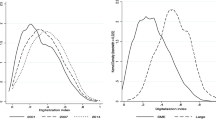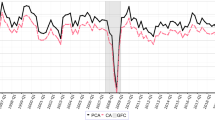Abstract
We analyze the impact of China’s growth on the exports of other Asian countries, distinguishing China’s demand for imports from its penetration of export markets. We account for the endogeneity of Chinese exports by applying instrumental variables in a gravity model with country-pair fixed-effects. We find that China’s crowding-out effect is felt mainly in markets for consumer goods and hence by less-developed Asian countries, not in markets for capital goods or by the more advanced Asian economies. Meanwhile, China has been sucking in imports from its Asian neighbors, but this effect is mainly felt in markets for capital goods. Hence, more and less developed Asian countries are being affected very differently by China’s rise.
Similar content being viewed by others
References
Ahearne, A. G., J. G. Fernald, P. Loungani, and J. W. Schindler (2003). China and Emerging Asia: Comrades or Competitors? International Finance Discussion Paper 789. Board of Governors of the Federal Reserve System, Washington, D.C.
Anderson, J. (1979). A Theoretical Foundation for the Gravity Equation. American Economic Review 69 (1): 106–116.
Anderson, J., and D. Marcouiller (2002). Insecurity and the Pattern of Trade: An Empirical Investigation. Review of Economics and Statistics 84 (2): 342–352.
Anderson, J., and E. van Wincoop (2003). Gravity with Gravitas: A Solution to the Border Puzzle. American Economic Review 93 (1): 170–192.
Eichengreen, B., and D. Irwin (1995). Trade Blocs, Currency Blocs, and the Reorientation of Trade in the 1930s. Journal of International Economics 38 (1): 1–24.
Ianchovichina, E., and T. Walmsley (2005). Impact of China’s WTO Accession on East Asia. Contemporary Economic Policy 23 (2): 261–277.
IMF (International Monetary Fund) (2004). The Global Implications of the U.S. Fiscal Deficit and of China’s Growth. World Economic Outlook (April): 63–102.
Mayer, J. (2003). The Fallacy of Composition: A Review of the Literature. UNCTAD Discussion Paper 166. United Nations Conference on Trade and Development, Geneva.
Rose, A. (2004). Do We Really Know That the WTO Increases Trade? American Economic Review 94 (1): 98–114.
Yang, T. Z., and D. Vines (2000). The Fallacy of Composition and the Terms of Trade of Newly Industrializing Economies. Unpublished manuscript. Oxford University.
Author information
Authors and Affiliations
Corresponding author
Additional information
JEL no.
E5, F4
About this article
Cite this article
Eichengreen, B., Rhee, Y. & Tong, H. China and the Exports of Other Asian Countries. Rev World Econ 143, 201–226 (2007). https://doi.org/10.1007/s10290-007-0105-0
Issue Date:
DOI: https://doi.org/10.1007/s10290-007-0105-0




